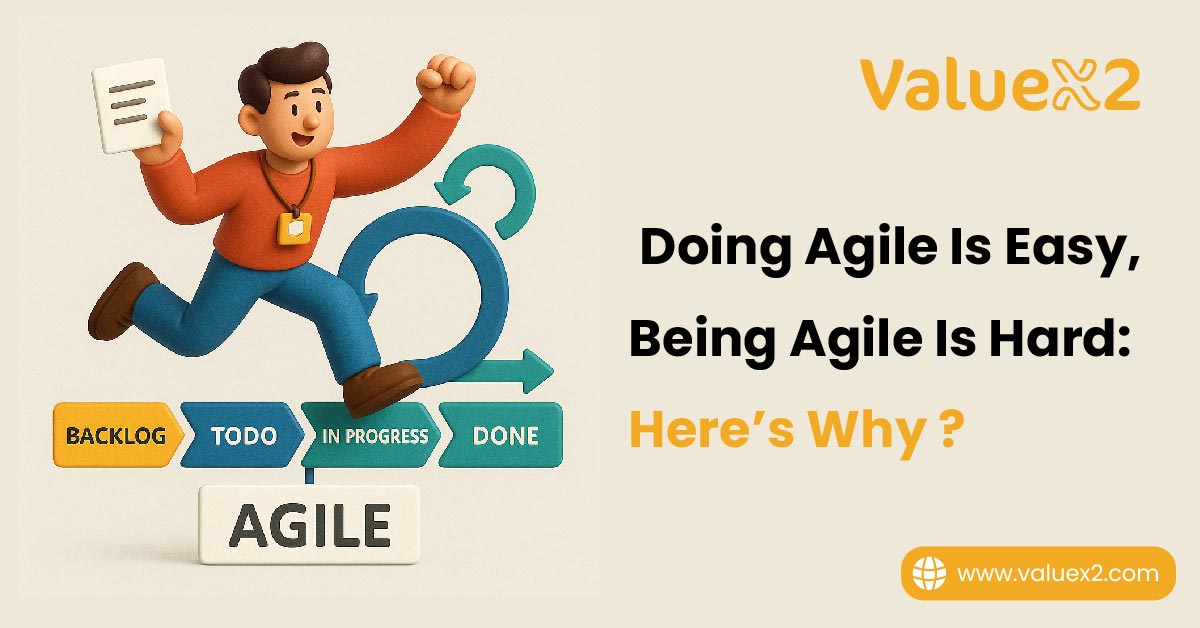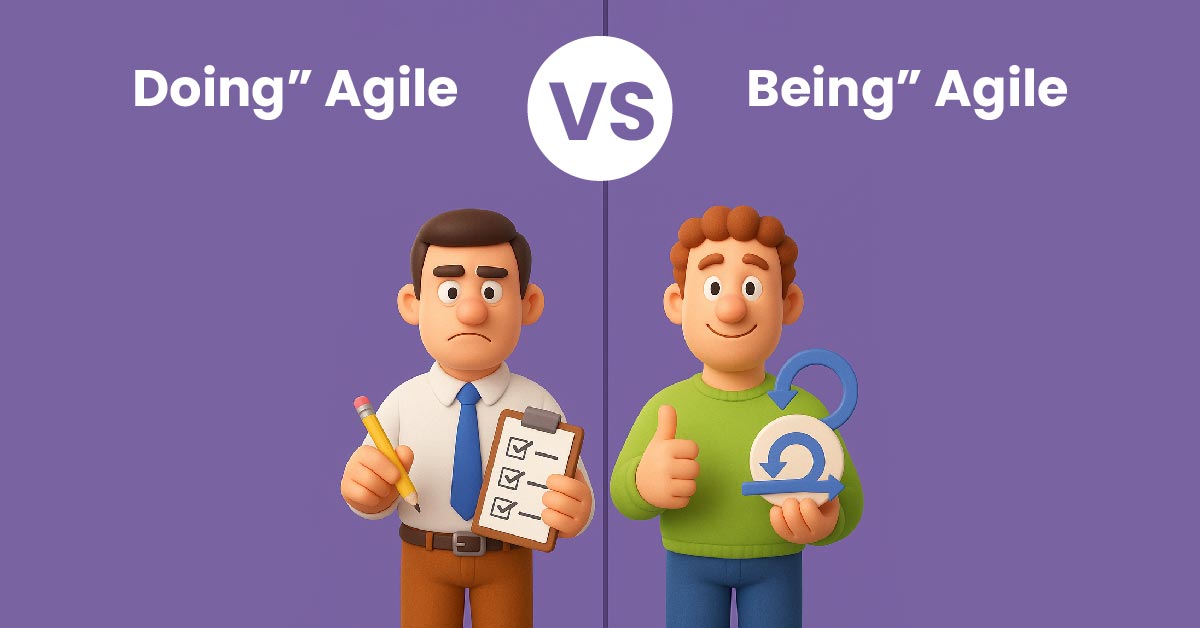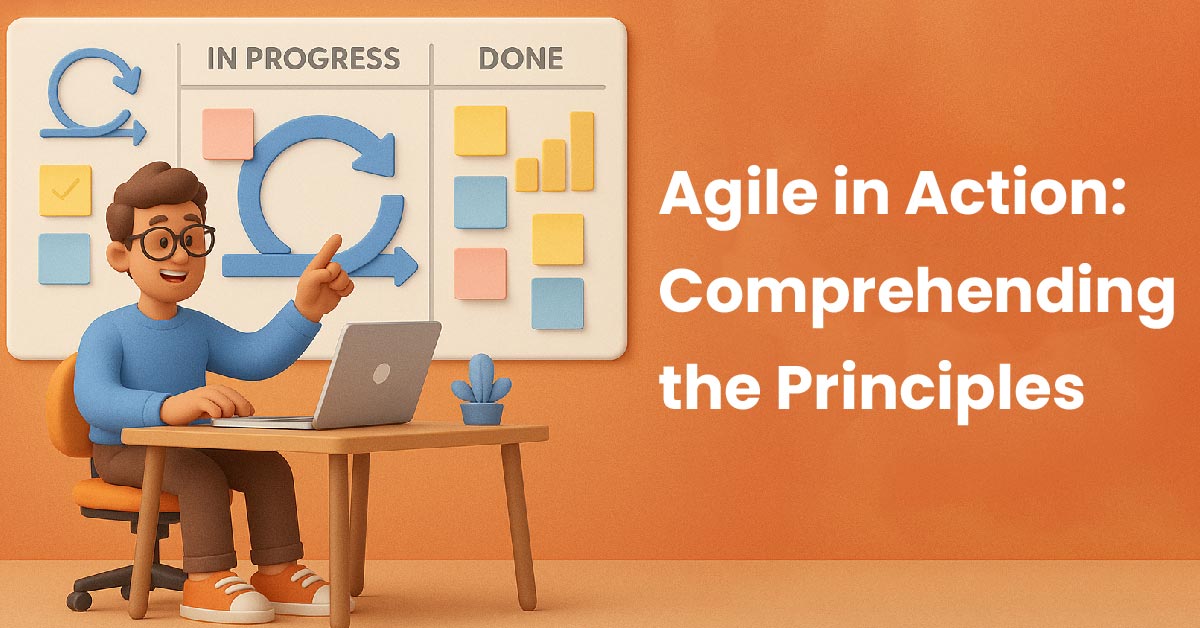Most teams do Agile. Few actually are Agile. Here’s what it will take for you to switch your team from “doing Agile” to being Agile. This blog is your guide to climbing to the Agile Maturity Pyramid in 2025. Don’t miss out on anything!
 The recent trend shows that it is much harder to get a job as an Agile Coach, Scrum Master, or Product Owner. What can candidates do in 2025 to secure these jobs? To keep up with the fast-changing landscape of things, “Agile” is a massive topic when it comes to change. Everybody from small startups to huge corporations seems to be using it. But there’s a valuable distinction often missed: being agile differs from doing agile.
The recent trend shows that it is much harder to get a job as an Agile Coach, Scrum Master, or Product Owner. What can candidates do in 2025 to secure these jobs? To keep up with the fast-changing landscape of things, “Agile” is a massive topic when it comes to change. Everybody from small startups to huge corporations seems to be using it. But there’s a valuable distinction often missed: being agile differs from doing agile.
This article will show you what differentiates “doing agile” from “being agile.” We will discuss six major principles of the Agile Manifesto. From these contrasts, you will know how to apply these principles in your company in a more agile fashion to get better results.
“Doing” Agile vs. “Being” Agile

Doing agile means you have to install tools, processes, and systems. It’s like recipe-following: you’re following the steps, using the proper ingredients, and hoping the outcomes will be good.
Generally, this means such as:
- Working with team methods: Using systems like Scrum or Kanban.
- Creating bigger systems: For big companies, this is SAFe or LeSS.
- Starting new meetings and activities: Stand-ups, sprint planning, and reviews become part of your life.
- Experimenting with new ways of working and tools: Documenting PBIs and utilizing software like Jira. You get the gist.
Although “doing agile” certainly makes you better at delivering and delivering faster, its true worth lies in whether it makes you agile.
Being agile is a heck of a lot more than tooling. It’s the nature of the Agile Manifesto, which says: “Individuals and interactions over processes and tools.” That means tools and processes are great to have, but the real power is in the attitude and behavior of your people.
As Mazdak Abtin explains, “When organizations are doing agile, they are asking, ‘What do I need to do Agile and how?”– which indicates that framework, methodology, tools, and techniques control them. Whereas when they are being Agile, they are asking, “Why do I need to be Agile and how?” This indicates that they are more concerned with the kind of behavior, mindset, and thinking that it requires.”
The tools and processes are just the beginning. Companies have to develop agile mindsets in order to be agile. This means looking at individuals’ values, attitudes, and behaviors, as well as how an organization is organized and its culture.
Building an Agile Mindset: What It Takes

An agile mindset means making drastic shifts in how individuals are managed, paid, trained, and hired.
- Trust and Accountability: People are enabled more, and managers are enablers, not directors. It gives rise to a sense of ownership.
- Rewards for Agile Behavior: Companies reward and celebrate behavior that reflects agility. It includes collaboration in close proximity, feedback in a short time, and making decisions that help agility in the long run.
- Meaningful Work: Individuals are driven by a definite objective and are able to own tasks that lead the business towards this objective. This lends meaning and purpose to their work.
- Beyond personal attitudes, to be agile also entails shifting how your business is structured and how it operates:
- Collaboration: Combining different roles can reduce delays, enhance collaboration, and make sure one team has all the expertise to finish a project from start to finish.
- Fewer Layers: Fewer managerial layers can remove responsibility distances and allow teams to structure themselves more easily.
- Leaders Lead by Example: Business leaders must really believe in agile values and not just ignore them when it is convenient to do so. Their commitment sets the tone for the culture of the entire organization.
- New Career Opportunities: Organizations might be compelled to rethink career roles and how people advance their careers in order to fit agile concepts into place and help people learn a range of skills.
This whole idea of “doing” and “being” agile is offered in the form of an “Agile Maturity Pyramid.” “Doing agile” is at the bottom, while “being agile” is at the top, reflecting a complete and lasting change.
Join the ranks of high-impact leaders with our Leading with Agile Training!
Agile in Action: Comprehending the Principles

Let us see how “doing” in contrast to “being” agile works out when we go through some key ideas from the Agile Manifesto. We will have a look at six key principles here.
Principle 1: Our priority is to meet the customer’s needs by delivering valuable software early and continually.
Doing Agile: A company “doing agile” can look at customer information, establish what customers need, and then write accurate tasks in the “as a customer, I want, so that” format. They create these tasks, and an effective agile team checks if the software meets user needs. This is a good start, leading to worthwhile small deliveries.
Being Agile: A company “being agile” goes further. They involve customers themselves in the process. Instead of just looking at data, they talk to customers to see how they feel and what they truly require. Through direct contact with the customers, “satisfying the customer” and “producing valuable software” becomes very clear. Those interactions happen regularly, giving immediate feedback to enhance the product. If you’re able to release a product to market before you can obtain feedback from a customer, then you do have a degree of flexibility to increase your agility. Try rapid “guerrilla testing” with early releases of your product – it can really make the final product awesome!
Principle 2: Welcome changing requirements, even late in development. Agile processes take advantage of change for the customer’s competitive edge.
Doing Agile: A company “doing agile” might accept changes, but they might also see them as frustrating interruptions. They might have systems to bring in changes, but generally, there’s still a feeling of frustration. Lots of changes might feel like a sign of bad planning instead of a chance to make things better.
Being Agile: Being agile really means not changing everything all the time; too many changes can definitely mean more work. However, a malleable organization responds to change in another manner. When new information comes along, a member who actually understands what the user requires will notice when it’s worth changing late. They’ll talk about it openly with their team, without hesitation for criticism. The team will be pragmatic and realize that things do shift by themselves. They’ll discuss the most appropriate decision, whether to change now or afterward. Importantly, they will plan for some unexpected work, or they’ll phase out other non-critical work to make space for a critical change. Both the team and everyone else know that making changes on occasion, even last minute, is beneficial to the customer and the product.
Principle 3: Produce working software on a regular basis, from a few weeks to a few months, with a bias towards the short timescale.
Doing Agile: When you’re “being agile,” one of the first things you’ll see is that you’re getting working software earlier. You’re shipping new bits every sprint. This software has already been tested and is deployable. This is much better than how we used to do things, where testing was an afterthought. But if you’re just breaking up a six-month project into two-week chunks without a bigger change of mind, you’re not quite agile yet.
Being Agile: True agility is not just about releasing working software regularly; it’s releasing software that works in whatever manner is most useful for the customer or the team. It’s not simply tested; it’s actually adding value or teaching you something you desperately need to learn. An agile firm is fine with releasing software that will perhaps be less than perfect but still be able to do the job or provide some lessons. The willingness to ship and learn first is a sure sign of genuine agility.
Principle 4: Developers and business people must collaborate daily during the project.
Doing Agile: Let’s consider two firms where everyone shares the same building. In the first scenario, “doing agile” might be like a Scrum team conducting its weekly meetings. Yet their PM might be in another department with other managers and is only present at some of the planning sessions. Their designer might be within an unrelated internal agency, having different objectives, and only in attendance at the team meetings for the projects they are assigned to. To the PM, “working together” might literally mean passing off finished designs to the team and asking when they are finished. The team can also do meaningful but “shadow” work to improve things that the PM does not see as being within their responsibility.
Being Agile: In the second and real agile organization, there is a small Scrum team composed of a Product Manager, a designer, and all the people needed to complete a project from start to finish, with few, if any, outside requirements. They share the same goals and different priorities. They work together to create solutions in face-to-face sessions. Because they work so closely, they pick up from each other new methods and knowledge and further increase their independence. The team can readily have impromptu, informal “jams” to change solutions based on emerging needs or ideas. Individuals on the team also actively share what they’re discovering and best practices with their teams. Unless companies change their design to allow for these complete “feature teams,” real teamwork will be a perpetual fantasy.
Principle 5: Encourage the team by putting projects together around great people. Please give them the proper environment and resources, and trust them to get it done.
Doing Agile: Companies “doing agile” will often use external rewards to motivate people. Those external rewards, like compliments or bonuses, might be closely linked to the quantity of work being done and, in more established settings, to the quality of work and appropriate behavior. Processes and rules, or even penalties, are used to make sure that people follow the processes, sometimes unknowingly perpetuating “old ways of working.”
To Be Agile: Companies “being agile” do continue to use extrinsic rewards, but additionally highly prize building intrinsic motivation. This means people do things because it is enjoyable and rewarding to them – the satisfaction of success, a feeling of being very good at something, or true interest in the work. One very straightforward way to build this internal motivation is through having an explicit, inspiring vision. Take IKEA’s vision seriously: “At IKEA, our vision is to create a better everyday life for many people.” Or Innocent Smoothies: “Make natural, delicious food and drink that helps people live well and die old.” Great visions provide people with purpose, which energizes their internal drive. Flexible minds build businesses around such self-motivated people, providing them with direction because, in the end, everything a company does, it does through its people.
Become an Agile Champion with our ICagile Business Agility Foundation Training in just 2 Days!
Principle 6: The best way to communicate to and within a development team is face-to-face discussion.
Doing Agile: An organization “practicing agile” might have daily stand-ups and regular meetings. They might encourage messaging with technology like Slack. However, too much reliance on them can unwittingly replace spoken conversation, leading to a “it’s on Slack” mentality that bars real teamwork.
Being Agile: In this instance, agility is the capacity to speak openly. If a developer needs a quick check with legal on some third-party license, the structure and culture of the organization have to allow that open communication without extraneous steps. And while tools like Slack are useful, they are in place in order to enable face-to-face conversation, not replace it. True agility is not just manifested during time-scheduled meetings, but also in impromptu, no-nonsense collaboration. A designer can call a developer and product manager over at a moment’s notice to toss around ideas about a problem that they just encountered. The spontaneous, informal discussion allows for quick problem-solving and mutual understanding.
Unlock Your Company’s Full Potential
The move from “doing agile” to “being agile” is big. It’s one of changing from merely following rules to having an energetic culture of collaboration, flexibility, and relentless delivery of value. It’s about empowering people, building intrinsic motivation, and developing a business that can not only withstand change but thrive because of it.
To truly embark on this pivotal journey and gain the profound knowledge required for true agility, ValueX2’s ICAgile Business Agility Foundations (ICP-BAF) Training & Certification is all you need to start with Agile. It equips you with the foundational knowledge and hands-on concepts to handle the challenges of agile transformation and create a truly agile organization. With this certification, you can showcase your latest knowledge of Agile concepts and get projects, salary hikes, and better opportunities in general. If you really want this positive change, start with Agile because that is the first step!
FAQs: Making Agile Clear
Q1: Is it bad to “do agile”?
A: Absolutely not! “Doing Agile” is generally the first thing you need to do. It brings good frameworks, processes, and tools that actually assist you in delivering work more effectively. But remember, these are just tools to an end and not the end itself. The real aim is to move past simply “doing” to actually “being” agile.
Q2: How long does it take to “be agile”?
A: There is no set period. Fully being agile is a constant process of changing your culture and way of thinking. It takes persistent effort, leadership buy-in, and willingness to learn and change. Some companies might see tangible changes in a year or two, but others might take longer, depending on where they start from and how committed they are.
Q3: What are the biggest problems in being truly agile?
A: Common problems are:
- Not willing to change: Humans like what they know.
- Lack of leadership support: If leaders don’t live by agile values, the change will not work.
- Department in silos: When teams don’t talk to each other, it hurts teamwork.
- Task-centric instead of outcome-centric: More worried about getting tasks done than creating value for customers.
- Fear of failure: Not able to experiment and learn from failure.
Q4: How can we tell whether we are “being agile”?
A: Besides simple metrics like the amount of work done, search for signs like:
- Are customers actively involved in the process and satisfied with what they get?
- Do employees feel trusted, in charge, and relevant?
- How rapidly does the organization adapt to new information and shifts in the market?
- Are teams working seamlessly with little lag?
- Is the software actually solving customer problems and having a business impact?

Bhavna is an Agile Coach and Consultant with 15+ years of experience in advisory, corporate finance, IT assurance, and operations at Big 4 and within the industry in the UK and India. She has recently been the CEO of a start-up where she implemented agile practices within HR, Marketing, and Product teams.
She is also a SAFe® Practice Consultant (SPC) and authorized instructor for ICAgile Agility in HR (ICP-AHR), Agility in Marketing (ICP-MKG), and Business Agility Foundations (ICP – BAF) training courses. She provides training for agile transformation to corporate, public, and private batches, as well as consulting for enterprise agile transformation.






